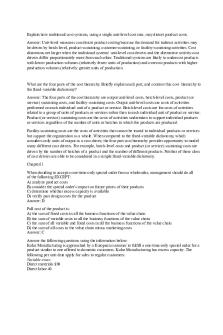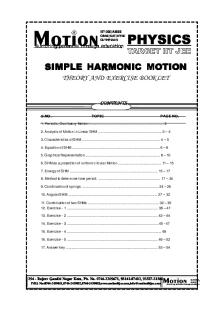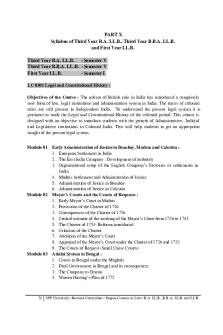Sprains and strains - NICE CKS PDF

| Title | Sprains and strains - NICE CKS |
|---|---|
| Author | Matthew O'Neill |
| Course | Contemporary Physiotherapy Practice |
| Institution | Coventry University |
| Pages | 27 |
| File Size | 652.4 KB |
| File Type | |
| Total Downloads | 40 |
| Total Views | 147 |
Summary
Download Sprains and strains - NICE CKS PDF
Description
Sprains and strains Last revised in March 2016
Next planned review by December 2021
Changes
Back to top
March 2016 — reviewed. A literature search was conducted in February 2016 to identify evidence-based guidelines, UK policy, systematic reviews, and key randomized controlled trials published since the last revision of this topic. No major changes to recommendations have been made, but the topic has been restructured.
Previous changes
Back to top
April 2015 — minor update. A link to the CKS topic on Analgesia has been inserted. February 2014 — minor update. The prescribing information has been updated to reflect new information from the manufacturer of piroxicam gel regarding reports of renal problems with piroxicam gel use. February 2013 — minor update. The 2013 QIPP options for local implementation have been added to this topic. October 2012 — reviewed. A literature search was conducted in September 2012 to identify evidence-based guidelines, UK policy, systematic reviews, and key randomized controlled trials published since the last revision of the topic. A change was made in the recommendations relating to specific management of severe sprains. May 2011 — minor update. The 2010/2011 QIPP options for local implementation have been added to this topic . Issued in June 2011. March 2011— topic structure revised to ensure consistency across CKS topics — no changes to clinical recommendations have been made. September 2010 — minor update. The Medicines and Healthcare products Regulatory Agency (MHRA) has recently advised that topical ketoprofen is associated with a risk of photosensitivity reactions. Issued in September 2010. June 2009 — minor update. The MHRA has recently reminded prescribers of the risk of photosensitivity reactions for people using topical ketoprofen. Issued in June 2009. March to July 2008 — converted from CKS guidance to CKS topic structure. The evidence-base has been reviewed in detail, and recommendations are more clearly justified and transparently linked to the supporting evidence. There were no major changes to the recommendations.
/
October 2006 — minor update. Analgesia prescriptions updated because new doses of ibuprofen for children are recommend by the British National Formulary (BNF). Issued in October 2006. July 2006 — minor update to drug rationales. Issued in July 2006. October 2005 — minor technical update. Issued in November 2005. July 2005 — update to text discussing nonsteroidal anti-inflammatory drugs (NSAIDs) in the Medicines management and Prescribing points sections. Issued in July 2005. January 2005 — reviewed. Validated in March 2005 and issued in April 2005. September 2001 — rewritten, with previous guidance on different types of sprains consolidated into one guidance on sprains in general. Validated in November 2001 and issued in April 2002. June 1998 — written.
Update
Back to top
New evidence
Back to top
Evidence-based guidelines No new evidence-based guidelines since 1 March 2016.
HTAs (Health Technology Assessments) No new HTAs since 1 March 2016.
Economic appraisals No new economic appraisals relevant to England since 1 March 2016.
Systematic reviews and meta-analyses No new systematic reviews or meta-analysis since 1 March 2016.
Primary evidence No new randomized controlled trials published in the major journals since 1 March 2016.
New policies
Back to top
No new national policies or guidelines since 1 March 2016.
/
New safety alerts
Back to top
No new safety alerts issued since 1 March 2016.
Changes in product availability
Back to top
No changes in product availability since 1 March 2016.
Goals
Back to top
To support primary healthcare professionals to: Ease pain, reduce swelling, and enable a person with a sprain or strain to return to their pre-injury level of function in the shortest possible time. Promptly refer people who need special assessment or treatment. Give advice on measures to prevent or reduce the risk of further sprains and strains.
Outcome measures
Back to top
No outcome measures were found during the review of this topic.
Audit criteria
Back to top
No audit criteria were found during the review of this topic.
QOF indicators
Back to top
No QOF indicators were found during the review of this topic.
QIPP - options for local implementation
Back to top
Non-steroidal anti-inflammatory drugs (NSAIDs) Review the appropriateness of NSAID prescribing widely and on a routine basis, especially in people who are at higher risk of both gastrointestinal and cardiovascular morbidity and mortality (for example, older people). If an NSAID is needed, use ibuprofen (1200 mg per day or less) or naproxen (1000 mg per day or less). Use the lowest effective dose and the shortest duration of treatment necessary to control symptoms. Review and, if appropriate, revise prescribing of etoricoxib to ensure it is in line with MHRA advice on the safety of selective COX-2 inhibitors (http://webarchive.nationalarchives.gov.uk/20141205150130/http://www.mhra.gov.uk/home/groups/plp/documents/websiteresources/con019458.pdf) and the NICE clinical guideline on Osteoarthritis (http://www.nice.org.uk/Guidance/CG177). Co-prescribe a proton pump inhibitor with NSAIDs for people who have osteoarthritis, rheumatoid arthritis, or for people over 45 years of age who have low back pain in accordance with NICE guidelines /
(see the NICE guidelines on O (http://www.nice.org.uk/Guidance/CG177)steoarthritis (http://www.nice.org.uk/Guidance/CG177), Rheumatoid arthritis (http://www.nice.org.uk/guidance/CG79), and Low back pain (http://www.nice.org.uk/guidance/CG88). [NICE, 2015 (/sprains-and-strains#!references)]
NICE quality standards
Back to top
No NICE quality standards were found during the review of this topic.
What is it?
Back to top
A sprain is a stretch and/or tear of a ligament (a strong band of tissue that connects the end of one bone to another). Sprains are classified by severity as: Grade I — mild stretching of the ligament complex without joint instability. Grade II — partial rupture of the ligament complex without joint instability. Grade III — complete rupture of the ligament complex with instability of the joint. They typically occur in the ankles, knees, wrists, and thumbs. A strain (or 'pull') is a stretch and/or tear of muscle fibres and/or tendon (fibrous cord of tissue that attaches muscles to bone). Strains are classified by severity as: First-degree (mild) strain — only a few muscle fibres are stretched or torn. Although the injured muscle is tender and painful, it has normal strength but power may be limited by pain. Second-degree (moderate) strain — there are several injured fibres and more severe muscle pain and tenderness. There is also mild swelling, noticeable loss of strength, and sometimes a visible bruise. Third-degree (severe) strain — the muscle tears all the way through, sometimes producing a 'pop' sensation as the muscle rips into two separate pieces or shears away from its tendon. There is a total loss of muscle function, severe pain and swelling, a visible bruise, and difficulty bearing weight. They typically occur in the foot, leg (especially the hamstring), and back.
[Jarvinen, 2000 (/sprains-and-strains#!references); Pugh, 2000 (/sprains-and-strains#!references); Struijs and Kerkhoffs, 2010 (/sprains-and-strains#!references); AAOS, 2015a (/sprains-and-strains#!references); BMJ, 2015 (/sprains-and-strains#!references)]
What are the causes and risk factors for sprains and
Back to top
strains? Sprains occur as a result of abnormal or excessive forces applied to a joint. Strains occur either because a muscle has been stretched beyond its limits or it has been forced to contract too strongly. The risk of strains and sprains is high in people who frequently participate in sport. Factors that increase the risk of injury during sports include: The type of sport — for example, contact sports (such as football, hockey, and boxing) and sports that feature quick starts (such as hurdling, long jump, and sprinting) increase the risk of strains; tennis, /
gymnastics, rowing, golf, and other sports that require extensive gripping increase the risk of hand sprains; and racquet games and throwing increase the risk of elbow sprains. Strength and flexibility — a lack of regular exercise can weaken muscles and joints, making them less flexible and hence more prone to injury. Poor exercise technique — this can cause excessive pressure to be applied to particular joints or muscles, thereby increasing the risk of injury. Wearing inappropriate footwear — this can increase the risk for developing ankle sprains and strains. Inadequate warm up before exercising, and cool down after exercising. Muscle fatigue — tired muscles are less likely to provide adequate support for the joints. Other risk factors for sprains and strains include: Sudden trauma, for example a fall, twist, or blow to the body. Anatomical variations of the foot and ankle (for example generalized joint laxity or flatfoot) — these may predispose a person to chronic injury. Type of muscle — some muscle types are more prone to injury than others, for example: More pennate muscles (short muscle fibres that extend from a central tendon) have a greater percentage of elongation before failure than less pennate muscles. Fast-twitch muscle fibres are more prone to injuries than slow-twitch muscle fibres. Muscle-tendon units that span two joints, for example the rectus femoris (which spans the hip and knee joints), are more commonly injured. Medical conditions that predispose to falls (for example epilepsy or balance disorders). Excessive alcohol intake and the use of drugs that can cause drowsiness (for example opioid analgesics). Being overweight or obese — this can put pressure on the joints and muscles. Previous sprain or strain. [Barrett and Bilisko, 1995 (/sprains-and-strains#!references); Jarvinen, 2000 (/sprains-andstrains#!references); Pugh, 2000 (/sprains-and-strains#!references); AAOS, 2015a (/sprains-andstrains#!references); BMJ, 2015 (/sprains-and-strains#!references)]
How common are sprains and strains?
Back to top
Sprains and strains are common, especially in people who frequently participate in sport and when there are predisposing factors (/sprains-and-strains#!backgroundSub:1). About 30–50% of musculoskeletal injuries that present in primary care are tendon and ligament injuries, with ankle injury being the most common in both athletes and sedentary people. CKS was unable to find specific UK incidence or prevalence data; however, in the US, musculoskeletal injuries account for about 2 million injuries per year and 20% of all sports injuries. [van Rijn et al, 2008 (/sprains-and-strains#!references); BMJ, 2015 (/sprains-and-strains#!references)]
What are the prognoses and complications?
Back to top
The prognosis of a sprain or strain largely depends on the severity (/sprains-andstrains#!backgroundSub) of the injury [Jarvinen, 2000 (/sprains-and-strains#!references); BMJ, 2015 (/sprains-and-strains#!references)]. A mild injury will usually heal within a few weeks with conservative treatment, with minimal long-term complications. /
A moderate injury should heal within a few weeks, but there is a high risk of further injury in the first 4–6 weeks. A severe injury may take months to heal fully, require surgical treatment, and result in complications, such as: For severe sprains — chronic instability, loss of function, pain, and secondary degenerative changes in the affected joint. For severe strains — muscle atrophy, muscle fibrosis, heterotrophic ossification, and compartment syndrome. In general: If a person with an ankle sprain has an uncomplicated recovery, walking is usually possible within 1–2 weeks, with function restored after 6–8 weeks, and a return to sporting activities after 8–12 weeks (depending on the severity of the injury) [de Bie et al, 2006 (/sprains-and-strains#!references)]. With ankle sprains, pain and intermittent swelling (particularly on the lateral side of the ankle) are the most common residual problems [Struijs and Kerkhoffs, 2010 (/sprains-and-strains#!references)]. CKS did not find any information on the prognosis for people with strains or other types of sprains.
How should I diagnose a sprain or strain?
Back to top
Ask about: How and when the injury occurred. Be alert to the possibility of abuse or domestic violence. The symptoms experienced, including the severity and the duration. Symptoms of a sprain typically include pain around the affected joint, tenderness, swelling, bruising, functional loss (for example pain on weight-bearing), and mechanical instability (if the sprain is severe). Symptoms of a strain typically include muscle pain, spasm, weakness, inflammation, and/or cramping. Large haematomas can occur as a result of tearing of the intramuscular blood vessels. There may be obvious swelling, although small haematomas or those deep within the muscle are more difficult to diagnose clinically. The severity of symptoms will depend on the severity (/sprains-and-strains#!backgroundSub) of the injury as well as the time since the injury. For example, it can take up to 24 hours for the full extent of bruising to become apparent. Symptom duration of more than a few days can suggest more severe injury. Any predisposing or risk factors (/sprains-and-strains#!backgroundSub:1), such as a medical condition or previous sprain or strain (enquire about the management and outcome). Any complicating factors, such as medication that may affect the injury (for example anticoagulants) or a complicating illness (for example neuropathy, bleeding disorder, or history of deep vein thrombosis). Perform a physical examination to assess the symptoms and to check for complications, including: A fracture, characterized by marked bruising, swelling, deformity, bony tenderness, and/or the inability to bear weight. Dislocation. Signs of septic arthritis (for example fever, a joint that is swollen and warm to the touch) or haemarthrosis (a very painful and tender joint swelling immediately after injury). Deformity of a limb, or postural abnormality. Damage to nerves or circulation. Arrange investigations (such as an X-ray, ultrasound, or an MRI [magnetic resonance imaging] scan), as appropriate, to: /
Determine the extent of an injury and/or assess for associated injuries. Exclude a fracture and other complications. See the section on X-ray (/sprains-and-strains#!diagnosisSub:1) for information on when to arrange an X-ray for a suspected fracture. Exclude differential diagnoses (/sprains-and-strains#!diagnosisSub:2), such as soft-tissue injuries, neurological disorders, or cancer.
Basis for recommendation
Back to top
These recommendations are largely based on expert opinion in the guidelines Clinical practice guidelines for physical therapy in patients with acute ankle sprain published by the Royal Dutch Society for Physical Therapy [de Bie et al, 2006 (/sprains-and-strains#!references)], Health care guideline: ankle sprain published by the Institute for Clinical Systems Improvement [ICSI, 2006 (/sprains-and-strains#!references)], and The diagnosis and management of soft tissue knee injuries: internal derangements. Best practice evidence-based guideline published by the New Zealand Guidelines Group [NZGG, 2003a (/sprains-andstrains#!references)], and on expert opinion in the review articles Musculoskeletal sprains and strains - BMJ Best Practice published by the British Medical Journal (BMJ) [BMJ, 2015 (/sprains-andstrains#!references)], Sprains, strains and other soft-tissue injuries published by the American Academy of Orthopaedic Surgeons (AAOS) [AAOS, 2015a (/sprains-and-strains#!references)], Management of ankle sprains [Wolfe et al, 2001 (/sprains-and-strains#!references)], and Muscle strain injuries [Jarvinen, 2000 (/sprains-and-strains#!references)]. The diagnosis of a muscle sprain or strain relies on taking a history of the injury as well as performing a clinical examination. Further diagnostic tests are required only if a fracture or other complications are suspected [BMJ, 2015 (/sprains-and-strains#!references)].
When should I arrange an X-ray?
Back to top
Arrange immediate referral to an Emergency Department for an X-ray if a fracture is suspected. The Ottawa rules (http://shs-manual.ucsc.edu/sites/shsmanual.ucsc.edu/files/Ottawa%20rules%20for%20x-ray%20of%20ankle%20&%20foot.pdf) recommend an X-ray in the following cases: Following an ankle injury, if there is pain in the malleolar zone, and one of the following: Inability to bear weight (walk four steps) immediately after the injury and when examined. Bone tenderness along the distal 6 cm of the posterior edge of the fibula or tip of the lateral malleolus. Bone tenderness along the distal 6 cm of the posterior edge of the tibia or tip of the medial malleolus. Following a foot injury, if there is pain in the midfoot zone, and one of the following: Inability to bear weight (walk four steps) immediately after the injury and when examined. Bone tenderness at the base of the fifth metatarsal. Bone tenderness of the navicular bone. Following a knee injury, if there is one or more of the following: Inability to bear weight (walk four steps) at the time of injury and when examined. The person is aged 55 years or more. Tenderness at the head of the fibula. Isolated tenderness of the patella. Inability to flex the knee to 90 degrees. /
An X-ray is also recommended: Following a wrist injury, if there is pain or tenderness over the scaphoid bone (palpate at the base of the anatomical snuff box). Use clinical judgement when considering an X-ray: For people who: Are younger than 18 years of age. Are intoxicated. Have multiple painful injuries, head injury, or diminished sensation in the lower extremities (for example due to neurological deficit). Have an altered mental status. Are pregnant. If gross swelling makes palpation of the area impossible. If there is a language barrier.
Basis for recommendation
Back to top
When to arrange an X-ray The recommendation on when to X-ray the ankle or foot is based on evidence from the Multicentre trial to introduce the Ottawa ankle rules for use of radiography in acute ankle injuries [Stiell et al, 1995a (/sprainsand-strains#!references)]. The use of these rules is also recommended in several guidelines, including the Canadian Guideline for the radiography of the ankle and foot (Ottawa ankle rules) published by the Alberta Medical Association [Alberta Medical Association, 2007 (/sprains-and-strains#!references)] and the Dutch Clinical practice guidelines for physical therapy in patients with acute ankle sprain [de Bie et al, 2006 (/sprains-andstrains#!references)]. Evidence suggests that the Ottawa ankle rules are highly sensitive for identifying fractures and may reduce unnecessary radiography and waiting times [Bachmann et al, 2003 (/sprains-and-strains#!references); Perry and Stiell, 2006 (/sprains-and-strains#!references)]. A systematic review found 21 primary studies and o>ne systematic review which confirmed the value of the Ottawa ankle rules at ruling out fractures after an ankle sprain. No evidence was found in favour of the use of MRI (magnetic resonance imaging) or CT (computed tomography) scan in the acute phase of ankle sprain [Jonckheer et al, 2015 (/sprains-and-strains#!references)]. The recommendation on when to X-ray the knee is based on evidence from studies on the use of the Ottawa knee rules: Der...
Similar Free PDFs

Sprains and strains - NICE CKS
- 27 Pages

Heart failure - chronic - NICE CKS
- 51 Pages

Simple Stress and Strains
- 12 Pages

Guppy Color Strains
- 240 Pages

Ch11 - nice
- 16 Pages

Pythonlearn - Nice
- 249 Pages

A3P1 - Nice
- 13 Pages

Unit1 - NICE
- 58 Pages

Naasa - Nice
- 4 Pages

Etech 2 - NICE
- 85 Pages

Dokument bez tytułu - nice
- 9 Pages

Manuale- NICE - BIO-FLO
- 1 Pages

Amcat automata 5 - Nice
- 2 Pages

Theory-jeemain - nice lectures
- 35 Pages

Llb syllabus 1 - Nice
- 4 Pages

Semana 6 - Nice
- 2 Pages
Popular Institutions
- Tinajero National High School - Annex
- Politeknik Caltex Riau
- Yokohama City University
- SGT University
- University of Al-Qadisiyah
- Divine Word College of Vigan
- Techniek College Rotterdam
- Universidade de Santiago
- Universiti Teknologi MARA Cawangan Johor Kampus Pasir Gudang
- Poltekkes Kemenkes Yogyakarta
- Baguio City National High School
- Colegio san marcos
- preparatoria uno
- Centro de Bachillerato Tecnológico Industrial y de Servicios No. 107
- Dalian Maritime University
- Quang Trung Secondary School
- Colegio Tecnológico en Informática
- Corporación Regional de Educación Superior
- Grupo CEDVA
- Dar Al Uloom University
- Centro de Estudios Preuniversitarios de la Universidad Nacional de Ingeniería
- 上智大学
- Aakash International School, Nuna Majara
- San Felipe Neri Catholic School
- Kang Chiao International School - New Taipei City
- Misamis Occidental National High School
- Institución Educativa Escuela Normal Juan Ladrilleros
- Kolehiyo ng Pantukan
- Batanes State College
- Instituto Continental
- Sekolah Menengah Kejuruan Kesehatan Kaltara (Tarakan)
- Colegio de La Inmaculada Concepcion - Cebu